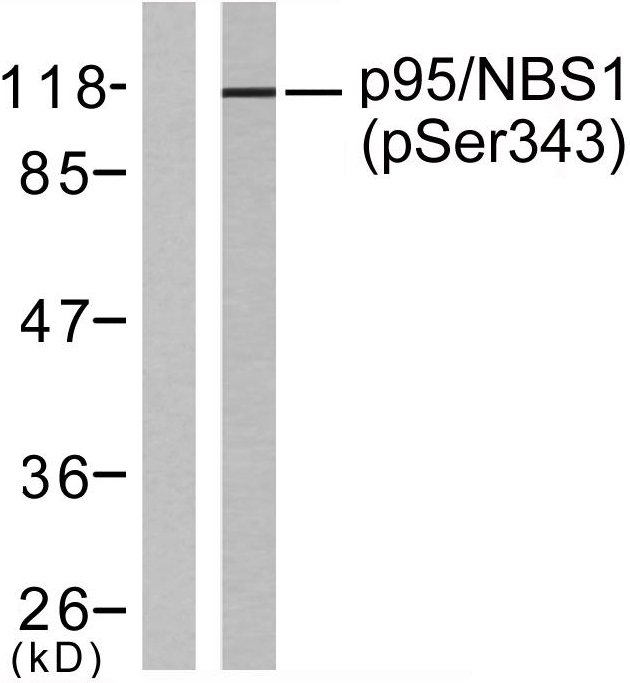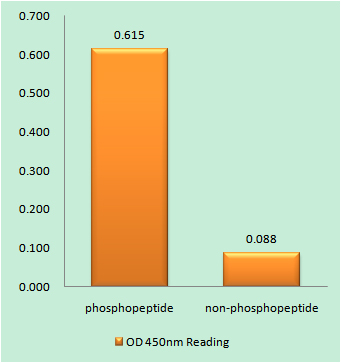Phospho p95-NBS1 (S278) Cell-Based Colorimetric ELISA Kit
- 货号:KA1532C
- 应用:ELISA
- 种属:Human
- 基因名称:
- NBN
- Human Gene Id:
- 4683
- Human Swiss Prot No:
- O60934
- Mouse Swiss Prot No:
- Q9R207
- 储存:
- 2-8°C/6 months
- 其他名称:
- Nibrin (Cell cycle regulatory protein p95) (Nijmegen breakage syndrome protein 1)
- 检测方法:
- Colorimetric
- 背景:
- disease:Defects in NBN are a cause of genetic susceptibility to breast cancer (BC) [MIM:114480]. BC is an extremely common malignancy, affecting one in eight women during their lifetime. A positive family history has been identified as major contributor to risk of development of the disease, and this link is striking for early-onset breast cancer.,disease:Defects in NBN are the cause of Nijmegen breakage syndrome (NBS) [MIM:251260]. NBS is an autosomal recessive syndrome characterized by chromosomal instability, radiation sensitivity, microcephaly, growth retardation, immunodeficiency and predisposition to cancer, particularly to lymphoid malignancies.,disease:Defects in NBN may be associated with aplastic anemia [MIM:609135]. Aplastic anemia is a disease of bone-marrow failure characterized by peripheral pancytopenia and marrow hypoplasia. Most of the cases of aplastic anemia are idiopathic, some are familial and some are due to a viral infection or to exposure to chemicals and radiation.,disease:Defects in NBN might play a role in the pathogenesis of childhood acute lymphoblastic leukemia (ALL).,domain:The C-terminal domain contains a MRE11-binding site, and this interaction is required for the nuclear localization of the MRN complex.,domain:The EEXXXDDL motif at the C-terminus is required for the interaction with ATM and its recruitment to sites of DNA damage and promote the phosphorylation of ATM substrates, leading to the events of DNA damage response.,domain:The FHA and BRCT domains are likely to have a crucial role for both binding to histone H2AFX and for relocalization of MRE11/RAD50 complex to the vicinity of DNA damage.,function:Component of the MRE11/RAD50/NBN (MRN complex) which plays a critical role in the cellular response to DNA damage and the maintenance of chromosome integrity. The complex is involved in double-strand break (DSB) repair, DNA recombination, maintenance of telomere integrity, cell cycle checkpoint control and meiosis. The complex possesses single-strand endonuclease activity and double-strand-specific 3'-5' exonuclease activity, which are provided by MRE11A. RAD50 may be required to bind DNA ends and hold them in close proximity. NBN modulate the DNA damage signal sensing by recruiting PI3/PI4-kinase family members ATM, ATR, and probably DNA-PKcs to the DNA damage sites and activating their functions. It can also recruit MRE11 and RAD50 to the proximity of DSBs by an interaction with the histone H2AX. NBN also functions in telomere length maintenance by generating the 3' overhang which serves as a primer for telomerase dependent telomere elongation. NBN is a major player in the control of intra-S-phase checkpoint and there is some evidence that NBN is involved in G1 and G2 checkpoints. The roles of NBS1/MRN encompass DNA damage sensor, signal transducer, and effector, which enable cells to maintain DNA integrity and genomic stability.,miscellaneous:In case of infection by adenovirus E4, the MRN complex is inactivated and degraded by viral oncoproteins, thereby preventing concatenation of viral genomes in infected cells.,PTM:Phosphorylated by ATM in response of ionizing radiation, and such phosphorylation is responsible intra-S phase checkpoint control and telomere maintenance.,sequence caution:Contaminating sequence. Potential poly-A sequence starting in position 550.,similarity:Contains 1 BRCT domain.,similarity:Contains 1 FHA domain.,subcellular location:Localizes to discrete nuclear foci after treatment with genotoxic agents.,subunit:Component of the MRN complex composed of two heterodimers RAD50/MRE11A associated with a single NBN. Component of the BASC complex, at least composed of BRCA1, MSH2, MSH6, MLH1, ATM, BLM, RAD50 and MRE11A (By similarity). Interacts with histone H2AFX this requires phosphorylation of H2AFX on 'Ser-139'. Interacts with HJURP, KPNA2 and TERF2.,tissue specificity:Ubiquitous. Expressed at high levels in testis.,
- 功能:
- cell cycle checkpoint, DNA damage checkpoint, M phase, telomere maintenance, in utero embryonic development, cell activation, blastocyst development, blastocyst growth, somatic diversification of immune receptors, somatic recombination of immunoglobulin genes during immune response, somatic diversification of immunoglobulins during immune response, adaptive immune response, immune effector process, immunoglobulin production, immunoglobulin production during immune response, production of molecular mediator of immune response, leukocyte mediated immunity, lymphocyte mediated immunity, adaptive immune response based on somatic recombination of immune receptors built from immunoglobulin superfamily domains, immune system development, somatic diversification of immune receptors via germline recombination within a single locus, DNA metabolic process, regulation of DNA replication, DNA repair,
- 细胞定位:
- Nucleus . Nucleus, PML body . Chromosome, telomere . Chromosome . Localizes to discrete nuclear foci after treatment with genotoxic agents (PubMed:26438602, PubMed:10783165, PubMed:26215093). Acetylation of 'Lys-5' of histone H2AX (H2AXK5ac) promotes NBN/NBS1 assembly at the sites of DNA damage (PubMed:26438602). .
- 组织表达:
- Ubiquitous (PubMed:9590180). Expressed at high levels in testis (PubMed:9590180).
- June 19-2018
- WESTERN IMMUNOBLOTTING PROTOCOL
- June 19-2018
- IMMUNOHISTOCHEMISTRY-PARAFFIN PROTOCOL
- June 19-2018
- IMMUNOFLUORESCENCE PROTOCOL
- September 08-2020
- FLOW-CYTOMEYRT-PROTOCOL
- May 20-2022
- Cell-Based ELISA│解您多样本WB检测之困扰
- July 13-2018
- CELL-BASED-ELISA-PROTOCOL-FOR-ACETYL-PROTEIN
- July 13-2018
- CELL-BASED-ELISA-PROTOCOL-FOR-PHOSPHO-PROTEIN
- July 13-2018
- Antibody-FAQs


